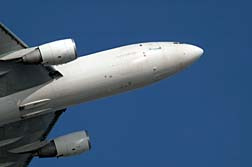 Curtis says that one of the biggest changes in airline safety in recent years is the availability of information for the public. "It used to be, back in 1991, that one of the key resources we [people in the industry] had was a set of file drawers with paper files from incidents," Curtis says. "It had NTSB [National Transportation Safety Board] reports, files and newspaper clippings. It was our best source of information and we used clues in those files to track down information.
Curtis says that one of the biggest changes in airline safety in recent years is the availability of information for the public. "It used to be, back in 1991, that one of the key resources we [people in the industry] had was a set of file drawers with paper files from incidents," Curtis says. "It had NTSB [National Transportation Safety Board] reports, files and newspaper clippings. It was our best source of information and we used clues in those files to track down information."The Web has changed all of that. You can get news reports immediately, cell phone videos are on YouTube and you can get information from different countries. When the incident with Qantas happened, the ATSB [Australia's version of the NTSB] gave press conferences and had multimedia information available. For the average person interested in aviation safety 17 years ago, the only decent information was at a well-equipped library or was only available if you were in the business."
Curtis says that the US is experiencing one of its safest periods of airline travel ever. "We are currently in a 26-month period where there have been no events in the US or Canada involving a larger aircraft in which people were killed. We've never been in a 26-month period prior to now with no passenger deaths. Safety is getting better, equipment is better and we have better knowledge in avoiding incidents. The overall system is safer.
"Now, in the developing world, in Africa and Asia, with airlines that can fly locally but can't qualify to fly internationally, that's where the accidents are happening."
Airline travel in the US is fairly safe, Curtis says. However, there are some things passengers can do to make their trip as safe as possible. "In the Qantas incident, everything was fine and dandy and then they had a sudden upset [a sudden drop in altitude]. A lot of people were injured because they were not belted in. If you're sitting in your seat and you're not getting up to go anywhere, keep your seatbelt on. Seventy people were injured, but there would have been far fewer injured if they had their belts on. That's in their control."
Another issue in air travel is air rage that is often linked to alcohol consumption. Curtis says that air travel is the one situation in which normal rules for drinking are suspended. So a person could be drinking on an airplane at 7:00 am while seated next to an unaccompanied child. According to Curtis, improvements are being made to the engineering and design of planes behind the scenes, but there needs to be an improvement in passenger behavior.
Other tips for passenger safety includes asking questions. "If you have an issue with the airline, if possible ask the airline directly. A lot of times, the issues come up at the airport. Don't keep it bottled in—ask someone and if you don't get a satisfactory response, follow up with a letter. But don't let it stew.
"Be aware of your surroundings on the plane. Review the safety card and get to know the safety exits. Be mindful of the people around you. If someone is behaving unusually, contact the flight attendant. If someone is acting out of turn, contact the flight attendant."
Of course, there are always myths about airplane safety, some of which have endured for a long time. Curtis says he has heard many myths, but one in particular stands out. "People always ask me where the safest part of the plane is to sit. Everyone has their ideas—they think the back of the plane is safest if your plane crashes into the side of the mountain. But, it turns out that, looking at the volumes of accident reports and seat maps of where people were killed, the answer is, if you can tell me they type of crash you'll be in, I'll tell you where to sit.
"During the Qantas incident, it didn't matter where you were sitting, if your seatbelt was on. The safest seat was the one in which the person had his seatbelt on. Another myth is that Qantas has never had a crash—technically speaking, it hasn't. Qantas has never had an event where people were killed. However, it has had several incidents."
READ MORE PLANE CRASH LEGAL NEWS
Dr. Todd Curtis founded and publishes AirSafe.com. He has previously worked as an airline safety analyst with Boeing and has written about airline safety in a book, Understanding Aviation Safety Data. He is frequently quoted in news articles about air safety, including articles in The Washington Post, The New York Times and The Wall Street Journal. The AirSafe website can be visited at www.airsafe.com.
